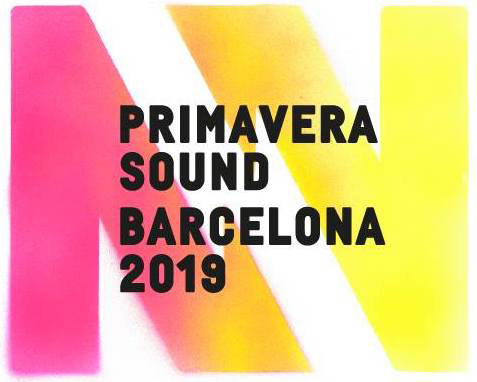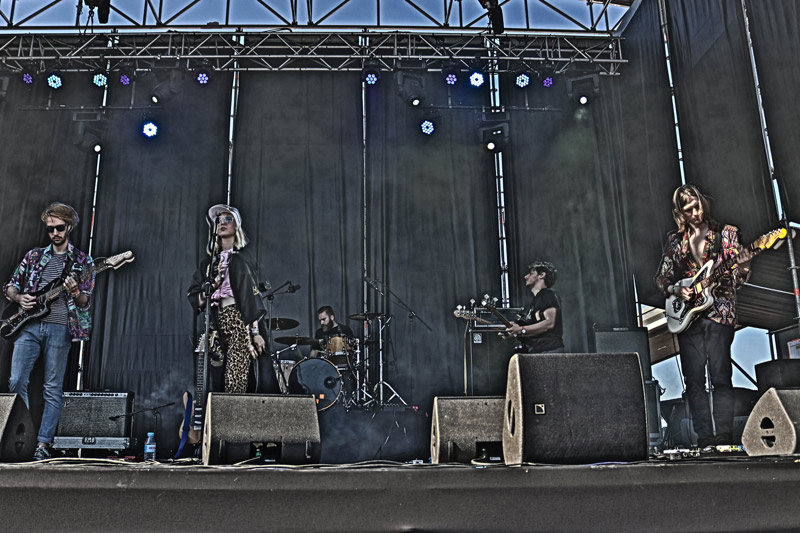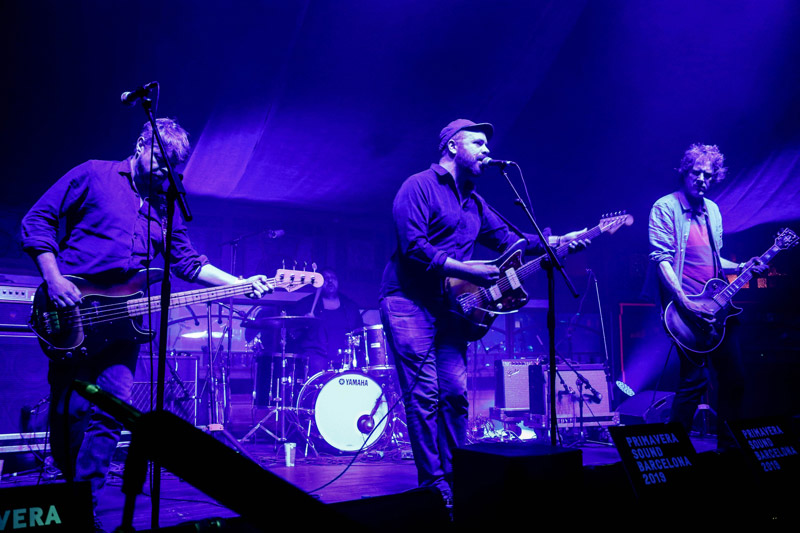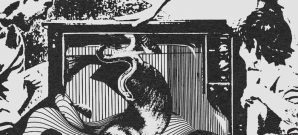
Once again, the Primavera Sound Festival in Barcelona, Spain, Monday, May 27th to Sunday, June 2nd, aimed to be the most progressive festival in Europe, but this year things didn’t turn out to be as amazing or surprising as usual.
MONDAY 27th MAY to WEDNESDAY 29th MAY
On Monday 27th May, Deerhunter took the Apolo stage in Barcelona. Theirs was a better gig than the one offered in 2018 (QRO recap), but I can’t help but feeling that they have lost their edge, that raw hysterical side they used to play with in the era prior to Microcastle (QRO review). Any time, a song required a climax – like “Helicopter” – they failed, and the gig was simply okay.
Tuesday started at the same venue with Cate Le Bon, but we only lasted two and a half songs there, so we directly went to see Poland’s Lonker See. The quartet achieves a solid and thunderous mix of stoner rock, psychedelia and jazz, all this thanks to an adventurous spirit that doesn’t seem to have a clear horizon. This was a treat hard to beat until we got to the Parc del Forum to watch the open-air side of the festival.
Last but not least at the Apolo was L8Chung. The Taiwanese singer-drummer offered a somehow typical far east pop, very romantic and very accessible, but played tightly and with energy. Not everyone’s cup of tea but hey, if they play in a festival near you don’t miss them.
On Wednesday nobody seemed interesting enough, not even Big Red Machine, the project of Justin Vernon (Bon Iver) and Aaron Dessner (The National), who by all accounts seems very much adapted to each other and asking Aaron’s twin brother Bryce (also of The National) to play guitar and Julien Baker to provide backing vocals, making a party of their gig.
THURSDAY MAY 30TH
Thursday started quietly and pleasantly. At the Auditorium, Bridget St. John debuted at the PS with a repertoire of her own compositions and some tributes to Bob Dylan or Joni Mitchell. Political, bucolic, pleasant, St. John was a soothing balm, a lesson in history of folk.
 Then, Julien Baker displayed a set based on melancholic and rather repetitive set of tunes. She tried to balance the gig with songs of her latest record, Turn On The Lights, and her debut record, but her problem was that she always played the same kind of song, always sang in the same high-pitch way and always used the same guitar tricks to create atmosphere. Fake stone pop.
Then, Julien Baker displayed a set based on melancholic and rather repetitive set of tunes. She tried to balance the gig with songs of her latest record, Turn On The Lights, and her debut record, but her problem was that she always played the same kind of song, always sang in the same high-pitch way and always used the same guitar tricks to create atmosphere. Fake stone pop.
Soccer Mommy were a ‘without pin or glory’ interlude before Stephen Malkmus & The Jicks. The Pavement ex-frontman and his band started in an electric way but soon filled the Primavera stage – the biggest one, if we don’t count the ‘Mordor’ ones, were the really big artists play at the PS – with slower and blander songs such as “Solid Silk”. Surprisingly boring.
Then, finally, a really good concert. At the Auditorium, Apparat returned to the fore with a new project, LP5, in which Sascha Ring keeps pushing the boundaries of the electronic-tinged pop he offered in Devil’s Walk, back in 2012. This time, pieces like “Dawan” were presented to an audience avid to know what the Berliner was on at the moment. Only in some specific moments, the music seems to loose focus, but all in all Ring is back with emotional, epic, expansive music that as he said plays more in structures and details than the melodies found in Devil’s Walk. But remember, Ring’s records tend to sound very different to the live experience. And LP5, his new opus, is not different.
Guided by Voices are one of those veteran bands you have to watch live at least once in your life to understand why titans like R.E.M. or indie pop favourites Nada Surf come from. After cancelling their gig of 2017 at the PS, an energetic set saw the band play 30 songs in 75 minutes, going back and forth their career with tunes like “Motor Away”, “The Rally Boys”, “I Am A Tree” or “Teenage FBI”. Definitely worthy live.
And our night was capped by Denmark’s Myrkur. Her take on black metal was surprisingly accessible, and there was something amusing in seeing her glowing with her pregnancy discuss the lack of sound onstage with the technician. Now seriously, a fluid set of songs that ranged from pure and simple black metal to some others showing a sort of accessibility was refreshing to see in a festival lost in urban outfits.
Elsewhere, Mac DeMarco was less energetic than his last visit in 2017, but good, for those who like him; Courtney Barnett was pretty convincing with her “what you see is what you get” attitude; Interpol were not surprising, but solid nonetheless; and Erykah Badu was pretty linear, but more reliable than many.
FRIDAY 31st MAY
Hungary’s Mayberian Sankülotts were relegated to the Night Pro Stage, where they offered a stimulating revision of some ‘80s sounds but mixed with shinny and flowing indie pop. Tracks like “Unreal” or “Empty Room” made for an entertaining gig of a band that, if they play their cards well, they can be big in Europe.
BEAK>, the “Fuck Brexit Official Band”, triumphed once again at the PS. Classics like “Eggdog”, “Wulfstan II” and “Blagdon Lake” blended with new tracks “Alle Sauvage”, “Brean Down” and “RSI” seamlessly, in a concert that means that the trio keep evolving in their special mixture of psychedelia, kraut and electronica, while keeping a recognizable sound and sense of humor.
Liz Phair was marred by awful sound, so the best thing instead was to stay for Jawbreaker. The trio doesn’t sound as punk as in the ‘90s, and they have refined some of their best songs like “Save Your generation” and “Fireman”. Effective, even if they lack some energy in certain moments.
I’m not a fan of Brit Pop, apart from one or two classics like Blur’s “Song 2”. That’s why I was surprised with Suede’s concert at the Ray-Ban stage. Vigorous, dynamic, committed, interactive, the quintet knew they were at a festival and they offered a festival-oriented gig. People danced to the sound of the disco of “Outsiders”, the summer melancholy of “So Young”, the rocky feel of “Filmstar”, the anthemistic “Life is Golden” and there was even space for an acoustic rendition of “The Wild Ones” with only Brett Anderson on guitar. Also, singer Anderson jumped into the audience several times, like he was a Les Savy Fav copycat, which was greatly appreciated. They knew what to offer and they chose the set accordingly, playing to the best of their strength. Surprisingly good.
Right after, one of the biggest highlights of the festival – alongside Apparat and BEAK> – Low with an intensity and clarity very few bands can reach nowadays. Supported by three LED screens that displayed different patterns mostly related to each of the songs, the trio from Duluth chose wisely from their catalogue. “Quorum”, “Always Up”, “No Comprende” or the epic noise climax of “Do You Know How To Waltz?” set them apart from almost the rest of the festival. A big open-air gig is not their natural habitat, but they were incredible in it.
Yves Tumor was a nice choice waiting for Swervedriver. His, at times, contemplative songs like the irresistible “Licking an Orchid” and a more direct approach to them onstage made for a pleasant experience, in a dog where he presented four new tracks.
Swervedriver were one of those bands that played in the tavern-like Hidden Stage of the PS. With almost 30 years and different shifts in style, they don’t sound like the stereotypical shoegaze band, but rather like a more rock-oriented one. Only in recent songs like “Future Ruins” the band shook off their monolithic sound, a way of playing and presenting the songs that make them difficult to distinguish.
Elsewhere, Tame Impala were the paradigm of modern psychedelia: songs, a certain attitude and a multi-coloured backdrop from projections that could give you colour blindness; and Kurt Vile helped the audience at Mordor to forget about the hard sun falling onto them.
SATURDAY 1st JUNE
The day started late with The Mystery of the Bulgarian Voices who, especially, had a very special guest in Dead Can Dance’s Lisa Gerrard. Supposedly, this project started life as BooCheeMish, where the choir invited Gerrard to join forces in a celebration of the folk culture of that area (to sum it up). But once onstage, the feeling is different.
The choir itself – in which you can still see its original director, Dora Hristova – was supported by a percussionist, a guitarist, a flute player and a violinist… and also, by a beatboxer.
The traditional songs are simply delightful, the singers don’t stop smiling and when some of them step forward to sing specific parts, they all hold hands supporting each other, which is really nice.
The only problem is that neither Gerrard nor the beatboxer seem to really fit in the ensemble. The singer had a considerable diva demeanour, which clashed with the exquisite simplicity of the choir; and the beatboxer, even if he is respectful and impressive, his intervention is way too cut off from the traditional vibe of the choir.
A lost opportunity to make of that concert something really memorable.
At the same time Built To Spill proved once again their savoir-faire in indie rock performing in its entirety Keep it Like a Secret. It’s not Perfect From Now On, but it helps understand the huge importance of the band in the most guitarist side of American indie rock of the late ‘90s.
Shellac are part of the furniture of the PS since… I don’t even remember. Even though they tend to play some of their classics, they also take the risk of playing new tracks that keep insisting in the energy and the rawness ,which are a trademark of the trio. Always effective, always fun, always reliable.
Suzanne Ciani has come back to the electronic side of music after almost 40 years focused on the classical side. Accompanied by her inseparable ‘Buchla’, the electronic device she used to create electronic landscapes, she was also supported by a couple of tablets set up to complement the kind of Blade Runner-esque quadraphonic sound. One can understand where the most ethereal Fennesz and Death in Vegas come from, but at times, she was working way too hard for the meagre amount of sounds emanating from the device.
We just caught the last couple of songs by Drab Majesty, and we regretted that, since the cosmic duo sounded like a couple of aliens playing songs that draw a lot from the most psychedelic The Cure. Enough to follow them! Then, at the Pitchfork Stage, Neneh Cherry offered a very chilled out repertoire, including hits “Man Child”, “Seven Seconds” and “Buffalo Stance”. The Swedish innovator felt extremely at ease on stage and even, if the set was not a masterpiece of energy, it certified a different kind of Kraft in a strange PS edition.
Back to the Primavera Stage to watch another of the indie headliners, Primal Scream. At times a bit at half speed, the quintet were in the same vein as Suede: ‘We’re in a festival and we’re gonna play songs so people can have fun.’ “Accelerator”, “Swastika Eyes”, “Kill All Hippies” or “Loaded” sounded pretty good but the group sounded somehow faded in some sections.
And finally, The Messthetics – the combo with Fugazi’s original drummer, Brendan Canty, and bassist Joe Lally, alongside guitarist Anthony Pirog – provided the audience with an all-instrumental set were they moved from experimental avant-jazz and noise songs and pure fast indie garage. As it happens with Yo La Tengo, every single time Pirog went experimental, trying noises and effects he was on the money, but when he got crazy noisy, he was unbearable. But, all in all, one of those bands worth watching live as they will give you a lot of energy.
Elsewhere, Róisín Murphy got the dancing bug, Jarvis Cocker was the eternal dandy and Stereolab offered a lesson in how to fuse pop with organic electronic sounds.
SUNDAY 2nd JUNE
The only gig worth watching was at the Barcelona Stage, in the Barcelona Contemporary Culture Centre, and it was Filthy Friends. Corin Tucker, Peter Buck and co. were fierce and bright, but they were a bit dampened by the sound, quite muddy and generally messy. Their take on indie rock is not as fresh as one expects and not many songs will stay in many people’s music players in five years, but they were honest enough and tried really hard to impress.
So this was the PS 2019 for us, the edition that changed it all. And it changed because the core of what the PS was changed. From now on it’ll be a mix of big mainstream names and big indie artists. Nothing wrong with that, at first, but then you have a look at the line-up and you realize the PS is now the urban version of Glastonbury.
There has been many names I haven’t mentioned here, of really big sellers such as Miley Cyrus, Rosalía, Nathy Peluso, James Blake, Robyn, Solange, cupcakKe, J Balvin, Nas and many in this vein… Names that just last year wouldn’t have been in the line-up.
A festival has to evolve, but I believe it has to keep an essence and the change this year into big urban artists it’s been made to increase the number of spectators so the PS can fight with Glasto, Coachella and other big commercial festivals. And that’s a pity, because with this, it has lost its main virtue: to bring artists that their core audience don’t have the chance to watch if, for the most part, the festival doesn’t bring them: The Church, Guided by Voices, Jawbreaker, Isis, Lift to Experience, June of 44, Sparks, Zeal &Ardor, Brian Wilson, Neutral Milk Hotel, Saint, Neurosis, Pavement, White Denim, Baxter Dury, The Fall, Health, Les Savy Fav…
Don’t get me wrong: most of those names already came to Barcelona by themselves but either it was long ago (The Church) or the venue was small enough not to gather a big audience. The PS always had spectators from all over Spain and Europe and for most of them the festival was the chance to see live some of their fave musicians.
And the other problem is the smell of corporatism. That the ‘market’ area, which in the past was filled with small indie labels, record shops, just causes and music posters, was now dismantled, sending the flagstock (posters) to a remote location with no transit of people whatsoever or the records shops – and no labels, apart from the PS one – reduced to six or seven tents was very sad to watch, especially since the original ‘market’ area was now filled with a big marquee from a sponsor. And all this, without talking about how awful the schedule was in some certain moments…
Sometimes, QRO Mag has been able to get me a press pass but since 2005 and even before the line-up was published I’ve always bought a VIP pack, that in recent years has gone to around 250 euros (around 290 US dollars), and if 80% of the headliners are alien to the core audience the festival and the schedule doesn’t allow you to watch some others, then it’s not worth it. Normally, those packs (the regular and the VIP ones) sold out fast. This year it seems there were many unsold.
Next year is the 20th anniversary, the PS will have a leg in LA and Pavement have already been confirmed for Barcelona, and it seems the festival will bring 20 benchmark artists of its past. But seeing how things have gone in 2019, most of us will wait until the line-up is published before getting anything.
-words & photos: Abel Cruz



























